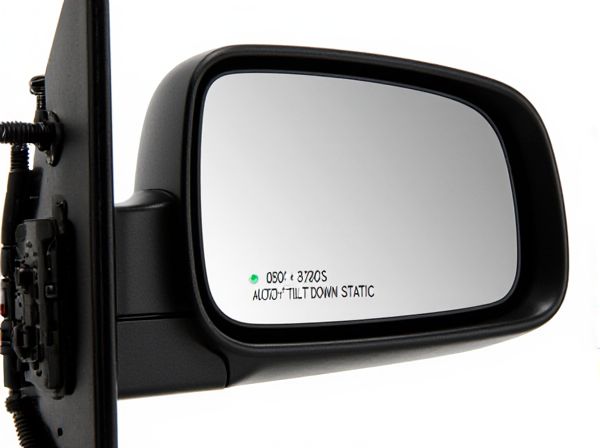
Photo illustration: Auto Tilt-Down vs Static
Auto tilt-down mirrors automatically adjust downward when you shift into reverse, providing enhanced visibility of the curb or parking lines without manual effort. Static mirrors remain fixed in position, requiring you to adjust them manually for better angles or parking precision. Choosing auto tilt-down mirrors simplifies parking and reduces the risk of curb damage, making them a practical upgrade for your vehicle.
Table of Comparison
| Feature | Auto Tilt-Down Mirror | Static Mirror |
|---|---|---|
| Function | Automatically tilts downward when reversing to improve curb visibility | Fixed position; manually adjusted only |
| Visibility | Enhanced rear tire and curb visibility for safer parking | Standard rearview without dynamic adjustment |
| Convenience | Hands-free adjustment based on gear position | Requires manual adjustment before parking |
| Safety | Reduces blind spots and risk of curb damage | Limited to static viewing angles |
| Cost | Higher due to electronic components and sensors | Lower cost, simpler design |
| Maintenance | May require sensor and motor maintenance | Lower maintenance needs |
Introduction to Auto Tilt-Down and Static Mirrors
Auto Tilt-Down mirrors automatically adjust downward when the vehicle is in reverse, enhancing visibility of curbs and obstacles to aid parking. Static mirrors remain fixed in position, requiring manual adjustment or reliance on the driver's natural eye angle for rear and side visibility. Auto Tilt-Down technology improves safety and convenience by minimizing blind spots and reducing the risk of damage during low-speed maneuvers.
How Auto Tilt-Down Mirrors Work
Auto tilt-down mirrors use electric motors controlled by the vehicle's gearshift or reverse sensor to automatically angle the passenger side mirror downward when the car is in reverse. This feature enhances visibility of the curb or parking lines, reducing blind spots and improving precision during parking maneuvers. In contrast, static mirrors remain fixed in position, requiring manual adjustment for optimal viewing angles.
Understanding Static Side Mirrors
Static side mirrors provide a fixed reflection angle, ensuring consistent visibility without automatic adjustments while driving or parking. Unlike Auto Tilt-Down mirrors that adjust downward when reversing to show the curb or ground, static mirrors require manual adjustment before driving to ensure proper rear and side views. Understanding the limitations of static side mirrors helps drivers avoid blind spots and enhances safety by prompting frequent manual checks.
Key Differences Between Auto Tilt-Down and Static
Auto Tilt-Down shutters feature adjustable louver angles controlled electronically or manually, enabling precise light and privacy management, while static shutters have fixed louvers that offer consistent airflow and light control without adjustment. Auto Tilt-Down systems often integrate with smart home technologies for automated operation, enhancing convenience and energy efficiency compared to the traditional, non-movable static designs. The key difference lies in flexibility and control, where auto tilt-down shutters provide dynamic shading options, whereas static shutters deliver a permanent, low-maintenance solution.
Advantages of Auto Tilt-Down Technology
Auto Tilt-Down technology offers significant advantages over static systems by enabling precise, automated adjustment of solar panel angles to maximize sunlight exposure throughout the day. This dynamic positioning increases energy efficiency and power output, reducing electricity costs and enhancing the return on investment for solar installations. Its adaptability to changing weather conditions and seasonal variations outperforms static panels, which remain fixed and often underperform outside optimal sunlight periods.
Benefits and Limitations of Static Mirrors
Static mirrors offer simplicity and durability with no moving parts, reducing maintenance needs and increasing longevity in vehicle side mirror applications. However, their fixed position limits visibility adjustment, potentially creating blind spots and reducing safety compared to Auto Tilt-Down mirrors that automatically adjust for optimal viewing angles during reversing or parking. The inability of static mirrors to adapt to various driving situations constrains their effectiveness in enhancing driver awareness and maneuverability.
Safety Impacts: Enhanced Visibility and Blind Spot Reduction
Auto tilt-down mirrors significantly improve safety by automatically angling downward when the vehicle is in reverse, enhancing visibility of the curb and low obstacles that are often missed with static mirrors. This dynamic adjustment reduces blind spots more effectively than static mirrors, allowing drivers to detect pedestrians, cyclists, and other hazards in close proximity. Studies show that vehicles equipped with auto tilt-down mirrors experience fewer low-speed collisions and enhanced maneuvering precision in tight spaces.
User Experience and Convenience Comparison
Auto Tilt-Down mirrors enhance user experience by automatically adjusting the mirror angle for optimal rear visibility when reversing, eliminating manual adjustments and reducing driver distraction. Static mirrors require manual positioning, which can be inconvenient and less precise, especially in tight parking scenarios or for users with limited mobility. Convenience significantly improves with Auto Tilt-Down technology, providing seamless, hands-free operation that adapts consistently to driving conditions.
Cost and Installation Considerations
Auto tilt-down solar panel systems generally have higher upfront costs due to more complex mechanical components and motorized controls, but they offer enhanced energy efficiency by optimizing panel angles throughout the day. Static solar panel installations have lower initial expenses and simpler, faster installation processes, making them cost-effective for projects with limited budgets or fixed mounting options. Maintenance costs for auto tilt-down systems can be higher over time due to moving parts, while static setups tend to incur minimal ongoing expenses.
Which is Right for You: Auto Tilt-Down vs Static?
Choosing between auto tilt-down and static options depends on your need for convenience and precision. Auto tilt-down blinds offer the advantage of automated adjustment, providing enhanced energy efficiency and ease of use, ideal for smart homes or frequent control. Static blinds deliver consistent positioning and lower maintenance, suitable for users preferring simplicity and manual operation without reliance on technology.
 caratoz.com
caratoz.com